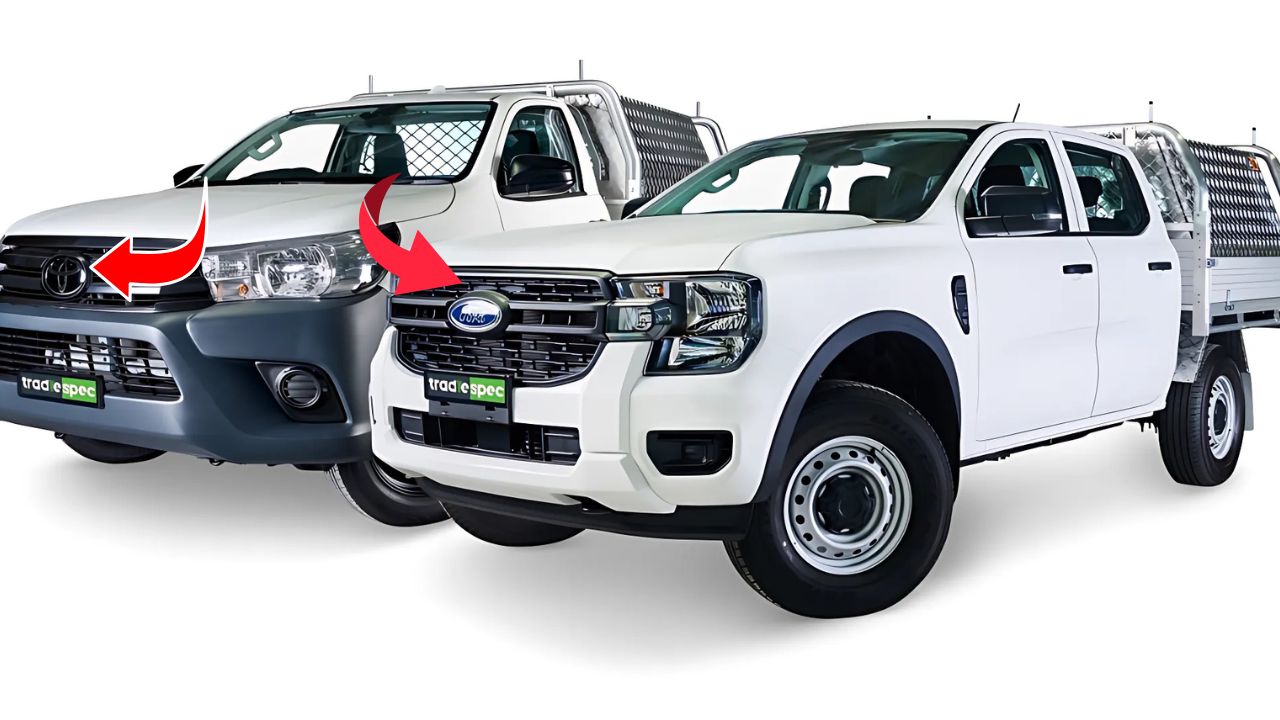The pickup truck market continues its relentless march forward. Two titans stand ready to battle for your hard-earned dollars in 2025.
Toyota’s legendary HiLux faces off against Ford’s refined Ranger. Both trucks promise durability, capability, and modern conveniences that today’s drivers demand.

2025 Pricing Breakdown: What Your Money Gets You
Toyota HiLux Starting Prices
The base HiLux Workmate kicks off at $24,990 for the single cab variant. This no-frills workhorse delivers essential truck functionality without breaking the bank.
Moving up the ladder, the SR trim starts at $32,490. You get more comfort features and better interior materials for the additional investment.
The popular SR5 commands $45,990 in dual-cab configuration. Most buyers gravitate toward this sweet spot between capability and comfort.
At the top sits the Rogue at $63,990. Premium leather, advanced safety tech, and luxury touches justify the hefty price tag.
Ford Ranger Price Points
Ford’s entry-level XL starts at $26,990 for regular cab models. The price advantage over Toyota quickly disappears when you add necessary options.
The XLT trim begins at $34,990 with meaningful upgrades. Ford includes more standard equipment compared to Toyota’s equivalent offerings.
Wildtrak models start at $52,990 with impressive off-road credentials. The price premium brings genuine capability improvements over lesser trims.
The range-topping Raptor demands $78,990 for its desert-racing DNA. Few trucks can match its extreme off-road performance capabilities.
Engine Performance: Power Under the Hood
HiLux Powertrain Options
The 2.7-liter four-cylinder petrol engine produces 122kW and 245Nm. This base engine suits light-duty work but struggles with heavy loads.
Toyota’s 2.8-liter turbo-diesel remains the popular choice. It delivers 150kW and 500Nm of torque for serious towing capability.
The diesel engine pairs with either a six-speed manual or automatic transmission. Both options provide smooth power delivery and reasonable fuel economy.
Toyota’s part-time 4WD system works reliably in challenging conditions. The mechanical simplicity means fewer expensive repairs down the road.
Ranger Engine Lineup
Ford’s 2.3-liter EcoBoost turbo petrol produces 202kW and 452Nm. This engine delivers impressive performance but drinks fuel under load.
The 3.2-liter five-cylinder diesel generates 147kW and 470Nm. While capable, it feels dated compared to modern four-cylinder alternatives.
Ford’s newer 2.0-liter bi-turbo diesel makes 157kW and 500Nm. This advanced engine combines strong performance with improved fuel efficiency.
The 10-speed automatic transmission works seamlessly with all engines. Gear changes happen smoothly, enhancing both performance and comfort.
Capability Comparison: Getting Work Done
Towing and Payload Specifications
The HiLux can tow up to 3,500kg when properly equipped. This capacity handles most boat trailers, caravans, and work equipment without drama.
Payload capacity reaches 1,245kg in Workmate trim. The carrying capacity drops slightly in higher trim levels due to additional equipment.
Ford Ranger matches the 3,500kg towing capacity across most variants. The engineering ensures stable towing behavior even with maximum loads.
Payload figures vary from 990kg to 1,267kg depending on configuration. The Raptor sacrifices some carrying capacity for its performance hardware.
Off-Road Performance
Toyota’s reputation for reliability shines in harsh conditions. The HiLux has proven itself in military service and commercial applications worldwide.
Ground clearance of 279mm allows confident navigation over rough terrain. The approach and departure angles accommodate steep obstacles without damage.
Ford’s Terrain Management System offers multiple drive modes. Electronic aids help maintain traction in sand, mud, and rocky conditions.
The Ranger Raptor takes off-road capability to another level. Fox Racing shocks and wider tracks enable high-speed desert running.
Interior Comfort and Technology Features
HiLux Cabin Experience
Base models feature durable cloth upholstery and manual adjustments. The focus remains on durability rather than luxury appointments.
Higher trims add leather-appointed seating and power adjustments. The materials quality improves noticeably but never reaches premium levels.
The infotainment system includes an 8-inch touchscreen with smartphone integration. Apple CarPlay and Android Auto come standard across the range.
Rear seat space accommodates adults comfortably in dual-cab models. The seating position works well for both short and long journeys.
Ranger Interior Quality
Ford emphasizes interior refinement across all trim levels. Even base models receive thoughtful touches that enhance daily usability.
The dashboard layout follows modern design principles with intuitive controls. Physical buttons remain for frequently used functions.
The SYNC 4A infotainment system operates smoothly with crisp graphics. The 12-inch vertical screen in higher trims looks impressive and works well.
Noise insulation keeps road and wind noise to acceptable levels. The cabin feels more car-like than traditional truck interiors.
Safety Technology and Driver Assistance
Toyota Safety Sense 2.0
All HiLux models include Toyota’s comprehensive safety suite. Pre-collision safety, lane departure alert, and automatic high beams come standard.
Dynamic radar cruise control maintains safe following distances. The system works effectively in stop-and-go traffic conditions.
Blind spot monitoring appears on higher trim levels. The warnings help prevent lane-change accidents in busy traffic.
Seven airbags protect occupants in various crash scenarios. Toyota’s reputation for crash safety extends to their truck lineup.
Ford Co-Pilot360
Ford includes extensive safety technology as standard equipment. Automatic emergency braking works at both low and highway speeds.
Blind spot information system monitors adjacent lanes effectively. Cross-traffic alert helps when backing out of parking spaces.
Lane keeping assist provides gentle steering corrections. The system works unobtrusively without fighting driver inputs.
Adaptive cruise control maintains speed and following distance. The technology reduces fatigue during long highway drives.
Fuel Economy and Running Costs
HiLux Efficiency Numbers
The diesel automatic achieves approximately 8.0L/100km in combined driving. Real-world figures typically run 1-2L higher depending on driving conditions.
Service intervals stretch to 10,000km for most variants. Toyota’s widespread dealer network keeps maintenance costs reasonable.
Parts availability remains excellent due to the model’s popularity. Independent mechanics can service most components without specialty tools.
Resale values stay strong thanks to the HiLux’s reputation. Three-year-old examples retain significant value in the used market.
Ranger Operating Costs
The bi-turbo diesel returns around 7.8L/100km in optimal conditions. The EcoBoost petrol engine consumes significantly more fuel under load.
Ford recommends 15,000km service intervals for diesel engines. The longer intervals help offset higher per-service costs.
Warranty coverage extends to five years or 200,000km. This comprehensive coverage provides peace of mind for high-mileage users.
Depreciation rates remain competitive but trail Toyota slightly. The gap narrows when comparing similar age and mileage examples.
Which Truck Delivers Better Value?
HiLux Advantages
Proven reliability record spans decades of global use. The mechanical simplicity reduces long-term maintenance complexity and costs.
Strong resale values protect your investment over time. Toyota’s reputation ensures buyers remain confident in used examples.
Widespread service network makes maintenance convenient anywhere. Rural areas often have Toyota dealers when other brands don’t.
Lower entry prices make the HiLux accessible to budget-conscious buyers. The Workmate provides genuine truck capability at reasonable cost.
Ranger Strengths

Superior interior refinement enhances daily driving comfort. The cabin feels more sophisticated than Toyota’s utilitarian approach.
Advanced engine technology delivers better performance and efficiency. The 10-speed automatic transmission operates more smoothly than Toyota’s six-speed.
Comprehensive standard equipment reduces option costs. Ford includes features that Toyota charges extra for.
The Raptor variant offers unmatched performance capabilities. No HiLux can match its extreme off-road performance.
Making Your Decision: Key Considerations
Budget plays the primary role in most truck purchases. The HiLux offers lower entry costs but the Ranger provides better standard equipment.
Intended use determines which features matter most. Work truck buyers prioritize durability while recreational users want comfort.
Long-term ownership costs favor the HiLux slightly. Lower maintenance and stronger resale values offset higher fuel consumption.
Test driving both trucks reveals significant differences in character. The HiLux feels more agricultural while the Ranger seems refined.
The Verdict
Both trucks serve their intended markets effectively. Your priorities determine which truck delivers better value for your specific needs.
Choose the HiLux for proven reliability and lower costs. Select the Ranger for modern refinement and advanced technology.
FAQs
Q: Which truck has better towing capacity?
Both trucks offer identical 3,500kg towing capacity when properly equipped.
Q: What’s the fuel economy difference between these trucks?
The Ford Ranger bi-turbo diesel slightly edges the HiLux with 0.2L/100km better economy.
Q: Which truck holds its value better?
Toyota HiLux historically maintains stronger resale values due to its reliability reputation.

